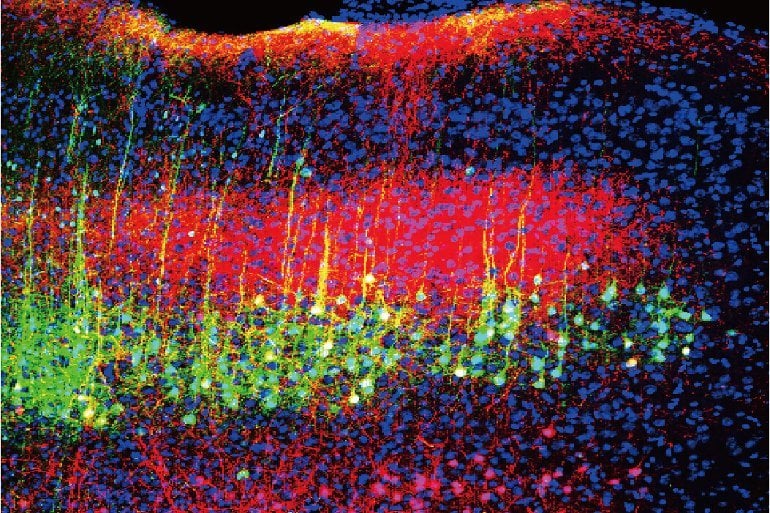Summary: Researchers have identified a network between the auditory cortex and thalamus that appears to blunt pain when an animal is exposed to specific sounds or noises.
Source: NIH
An international team of scientists has identified the neural mechanisms through which sound blunts pain in mice.
The findings, which could inform development of safer methods to treat pain, were published in Science.
The study was led by researchers at the National Institute of Dental and Craniofacial Research (NIDCR); the University of Science and Technology of China, Hefei; and Anhui Medical University, Hefei, China. NIDCR is part of the National Institutes of Health.
“We need more effective methods of managing acute and chronic pain, and that starts with gaining a better understanding of the basic neural processes that regulate pain,” said NIDCR Director Rena D’Souza, D.D.S., Ph.D.
“By uncovering the circuitry that mediates the pain-reducing effects of sound in mice, this study adds critical knowledge that could ultimately inform new approaches for pain therapy.”
Dating back to 1960, studies in humans have shown that music and other kinds of sound can help alleviate acute and chronic pain, including pain from dental and medical surgery, labor and delivery, and cancer. However, how the brain produces this pain reduction, or analgesia, was less clear.
“Human brain imaging studies have implicated certain areas of the brain in music-induced analgesia, but these are only associations,” said co-senior author Yuanyuan (Kevin) Liu, Ph.D., a Stadtman tenure-track investigator at NIDCR.
“In animals, we can more fully explore and manipulate the circuitry to identify the neural substrates involved.”
The researchers first exposed mice with inflamed paws to three types of sound: a pleasant piece of classical music, an unpleasant rearrangement of the same piece, and white noise. Surprisingly, all three types of sound, when played at a low intensity relative to background noise (about the level of a whisper) reduced pain sensitivity in the mice. Higher intensities of the same sounds had no effect on animals’ pain responses.
“We were really surprised that the intensity of sound, and not the category or perceived pleasantness of sound would matter,” Liu said.
To explore the brain circuitry underlying this effect, the researchers used non-infectious viruses coupled with fluorescent proteins to trace connections between brain regions.

They identified a route from the auditory cortex, which receives and processes information about sound, to the thalamus, which acts as a relay station for sensory signals, including pain, from the body. In freely moving mice, low-intensity white noise reduced the activity of neurons at the receiving end of the pathway in the thalamus.
In the absence of sound, suppressing the pathway with light- and small molecule-based techniques mimicked the pain-blunting effects of low-intensity noise, while turning on the pathway restored animals’ sensitivity to pain.
Liu said it is unclear if similar brain processes are involved in humans, or whether other aspects of sound, such as its perceived harmony or pleasantness, are important for human pain relief.
“We don’t know if human music means anything to rodents, but it has many different meanings to humans—you have a lot of emotional components,” he said.
The results could give scientists a starting point for studies to determine whether the animal findings apply to humans, and ultimately could inform development of safer alternatives to opioids for treating pain.
About this pain and auditory neuroscience research news
Author: Press Office
Source: NIH
Contact: Press Office – NIH
Image: The image is credited to Wenjie Zhou
Original Research: Closed access.
“Sound induces analgesia via corticothalamic circuits” by Wenjie Zhou et al. Science
Closed access.
“Sounding out pain” by Rohini Kuner et al. Science
Abstract
Sound induces analgesia via corticothalamic circuits
Sound—including music and noise—can relieve pain in humans, but the underlying neural mechanisms remain unknown. We discovered that analgesic effects of sound depended on a low (5-decibel) signal-to-noise ratio (SNR) relative to ambient noise in mice.
Viral tracing, microendoscopic calcium imaging, and multitetrode recordings in freely moving mice showed that low-SNR sounds inhibited glutamatergic inputs from the auditory cortex (ACxGlu) to the thalamic posterior (PO) and ventral posterior (VP) nuclei.
Optogenetic or chemogenetic inhibition of the ACxGlu→PO and ACxGlu→VP circuits mimicked the low-SNR sound–induced analgesia in inflamed hindpaws and forepaws, respectively. Artificial activation of these two circuits abolished the sound-induced analgesia.
Our study reveals the corticothalamic circuits underlying sound-promoted analgesia by deciphering the role of the auditory system in pain processing.
Abstract
Sounding out pain
The perception of physical pain is subject to variation depending on the context and which other sensory inputs are being received, including sound.
The emerging field of music therapy—which is applied to control postoperative, pediatric, postpartum, and cancer pain and is being increasingly tested in chronic pain disorders—capitalizes on the interactions between sound and pain perception to attenuate pain.
Given that music and natural sounds can positively affect mood, relieve stress, and relax the body, it is not unreasonable to think that these factors underlie pain relief.
On page 198 of this issue, Zhou et al. demonstrate that pain relief by sound is not purely attributable to stress reduction and distraction. They interrogate neural circuits to unravel a specific pathway for sound-induced analgesia in the brains of mice.






